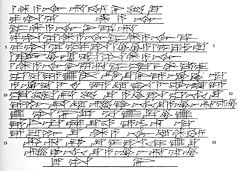Ashur-rim-nisheshu
| Ashur-rim-nisheshu | |
|---|---|
| Issi'ak Assur | |
| King of Assur | |
| Reign | c. 1408–1401 BC[1] |
| Predecessor | Ashur-bel-nisheshu |
| Successor | Ashur-nadin-ahhe II |
| Issue | Ashur-nadin-ahhe II |
| Father | Ashur-bel-nisheshu |
Aššur-rā’im-nišēšu, inscribed mdaš-šur-ÁG-UN.MEŠ-šu, meaning “(the god)
Biography

All three extant Assyrian Kinglists[i 2][i 3][i 4] give his filiation as “son of Aššur-bēl-nišēšu," the monarch who immediately preceded him, but this is contradicted by the sole extant contemporary inscription, a cone giving a dedicatory inscription for the reconstruction of the wall of the inner city of Aššur, which gives his father as Aššur-nērārī II (written phonetically on the third line of the illustration),[3] the same as his predecessor who was presumably therefore his brother. With Ber-nādin-aḫḫe, another son of Aššur-nērārī who was given the title "supreme judge," it seems he may have been the third of Aššur-nērārī's sons to rule.[4]
The cone identifies the previous restorers as Kikkia, Ikunum (1867–1860 BC), Sargon I (1859 BC – ?), Puzur-Aššur II, and Aššur-nārāri I (1547–1522 BC) the son of Ishme-Dagan II (1579–1562 BC).[5] The reference to Kikkia's original fortification of the city is repeated in one of the later king's, Salmānu-ašarēd III, own inscriptions.[6] It was recovered from an old adobe wall three meters from the northern edge of the ziggurat.[7]
He was succeeded by his son, Aššur-nadin-aḫḫē II.
Inscriptions
References
- ISBN 978-9004430914.
- ^ K. Radner (1998). The Prosopography of the Neo-Assyrian Empire, Volume 1, Part I: A. The Neo-Assyrian Text Corpus Project. p. 209.
- ^ J. A. Brinkman (1973). "Comments on the Nasouhi Kinglist and the Assyrian Kinglist Tradition". Orientalia. 42: 312.
- ^ B. Newgrosh (1999). "The Chronology of Ancient Assyria Re-assessed". Journal of the Ancient Chronology Forum. 8: 80.
- ^ A. K. Grayson (1972). Assyrian Royal Inscriptions, Volume I. Wiesbaden: Otto Harrassowitz. pp. 39–40.
- ^ Hildegard Lewy (1966). The Cambridge Ancient History: Assyria c.2600-1816 B.C. p. 21.
- ^ L. Messerschmidt (1911). Keilschrifttexte aus Assur Historischen Inhalts, Erstes Heft. VDOG. p. xii.
